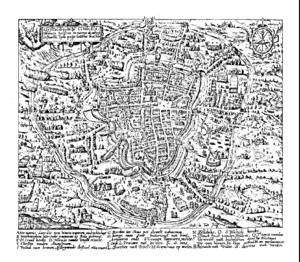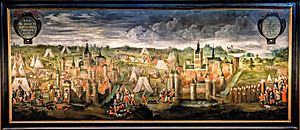Siege of Ypres (1383) facts for kids
Quick facts for kids Siege of Ypres |
|||||||
|---|---|---|---|---|---|---|---|
| Part of Despenser's Crusade and the Revolt of Ghent (1379–1385) | |||||||
 Ypres during the Bishop of Norwich's siege. The illustration, a reproduction of an engraving published in 1610, shows the siege in progress |
|||||||
|
|||||||
| Belligerents | |||||||
| City of Ypres County of Flanders Kingdom of France |
Kingdom of England Ghent rebels |
||||||
| Commanders and leaders | |||||||
| John d'Oultre Louis II of Flanders |
Henry le Despenser | ||||||
| Strength | |||||||
| ~ 20,000 | Unknown | ||||||
| Casualties and losses | |||||||
| Unknown | Unknown | ||||||
The siege of Ypres was a major battle that happened between June 8 and August 8, 1383. It was part of a bigger conflict called Despenser's Crusade and the Revolt of Ghent (1379–1385). During this siege, English soldiers and fighters from the city of Ghent tried to capture the city of Ypres. However, their attempt failed, and Ypres successfully defended itself.
Contents
Why the Siege Happened
The city of Ghent was located in a region called Flanders. In September 1379, Ghent decided to rebel against its ruler, Louis of Male. Louis supported France in the Hundred Years' War, a long conflict between England and France. This support went against what was best for Flanders' economy, especially its trade with England.
After a big defeat in November 1382 at the Battle of Roosebeke, the people of Ghent asked England for help. England sent an army led by Henry le Despenser, who was the Bishop of Norwich.
The English army landed in Calais in May 1383. They quickly took control of several towns like Gravelines, Dunkirk, Poperinge, and Nieuwpoort. On May 25, the English and their allies defeated a French and Flemish army near Dunkirk. After this victory, Despenser was convinced by his allies from Ghent and some of his own officers to attack Ypres. Ypres had remained loyal to the Count of Flanders and to France.
The Battle for Ypres
The people of Ypres were ready for a fight when the English and their allies arrived on June 8, 1383. They had prepared well for the siege. People living in the areas outside the city walls had left their homes. The wood from these abandoned houses was used to make the city's earth walls and stone gates stronger. Ypres had also sent a message to Paris to get more gunpowder for their cannons.
The city was very well organized under the command of John d'Oultre, who was the Castellan (or governor) of Ypres. The city was divided into different areas, each with its own defense plan. Even though the city walls were not very tall, they were well protected. There was a double ditch filled with water, a thick thorny hedge with sharp stakes, and a strong wooden fence.
First Attacks on the City Gates
On the first day, the English attacked the Temple Gate but were pushed back. Over the next three days, they tried to attack all the city gates at the same time, but they couldn't get through.
Before the end of the first week, more English soldiers arrived and completely surrounded the city. They managed to fill in parts of the outer ditch with soil.
Artillery and Continued Attacks
On the eighth day of the siege, June 15, Despenser used artillery (cannons) to attack the city's defenses. They fired at the Messines Gate and caused some damage, but not enough to break through the city's defenses. For the next few days, the constant cannon attacks didn't have much effect. All the attacks by Despenser's soldiers were stopped by the defenders of Ypres.
There was an attempt to drain the water from the ditches, which was a serious threat to Ypres. However, this attempt failed. The people inside Ypres managed to send messages to the Duke of Burgundy through Louis of Male. This allowed a large French army to be gathered to help the city.
On August 8, after nine weeks of trying, Despenser suddenly decided to give up the siege. His allies from Ghent also left on September 10.
The people of Ypres believed their victory was thanks to the help of Our Lady of the Enclosure. To honor her, they have held a special procession every year on the first Sunday in August since then.
What Happened Next
After the failure at Ypres, Bishop Despenser and Sir Hugh Calveley wanted to move into France. However, other commanders refused. The approaching French army forced the bishop to retreat to Gravelines. The English soldiers were tired and sick. They were paid to leave Gravelines, and Despenser ordered the town to be looted before they left. By the end of October, the remaining English soldiers had returned across the English Channel.
Ghent continued its rebellion for a while longer. It finally made peace in 1385 with Philip the Bold, who had taken over from Louis of Male.
Ypres never fully recovered from this siege. The entire area around the city was destroyed, and its important trade with England was badly hurt. The city continued to decline. Its population dropped from about 20,000 people in 1383 to only 7,600 by the end of the 1400s.


